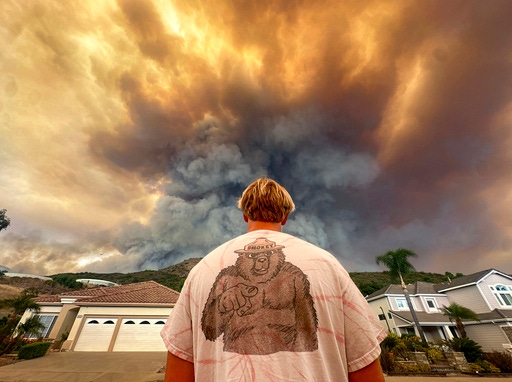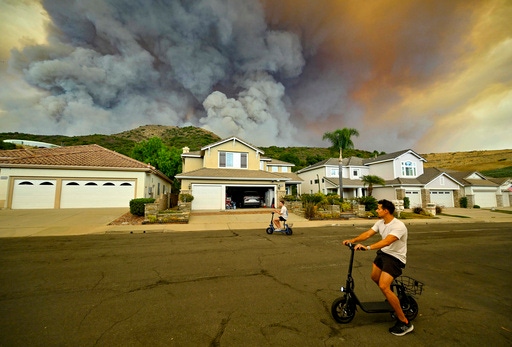Cool weather forecast offers hope in battling intense Southern California blaze

Aidan Thomas wears a Smokey Bear t-shirt as he watches smoke from the Airport Fire rise behind Meander Lane in Trabuco Canyon, Calif., on Monday, Sept. 9, 2024. (Jeff Gritchen/The Orange County Register via AP)[ASSOCIATED PRESS/Jeff Gritchen]
MOUNTAIN HOME VILLAGE, Calif. (AP) — Several days of extreme temperatures have stoked a wildfire in Southern California that burned so hot it created its own thunderstorm-like weather systems, but firefighters hope to gain the upper hand as cooler weather is expected to move in after Tuesday.
The so-called Line Fire has forced at least 6,000 people to evacuate, and threatened thousands of homes and commercial structures as it burns along the edge of San Bernardino National Forest, about 65 miles (105 kilometers) east of Los Angeles.
“We’re dealing with triple-digit temperatures and hard-to-reach steep areas where there has not been fire in decades, or in recorded history, so all that vegetation has led to significant fuel loads,” Cal Fire spokesperson Rick Carhart said.
The conditions have limited firefighters’ ability to control the blaze, which has created the type of clouds that can spawn gusty winds and lightning strikes.
Three firefighters have been injured since the blaze was reported Thursday, state fire managers said.
An excessive heat warning issued for the Los Angeles area will expire Tuesday night.
As of Tuesday morning, the blaze had charred about 41 square miles (96 square kilometers) of grass and brush and blanketed the area with a thick cloud of dark smoke. It was 5% contained.
The blaze is one of many burning across the West, including in Idaho, Oregon and Nevada, where about 20,000 people had to flee a fire outside Reno.
The Line Fire is one of the most dangerous of many in California, including one north of San Francisco that destroyed more than two dozen homes and another that broke out in Orange County, southeast of Los Angeles.
Stephen Richardson, whose 1930s cabin in the unincorporated community of Mountain Home Village is in the path of the Line Fire, said Monday that he installed more fire-resistant siding to the wooden structure and trimmed some branches away from it.
“That’s about all I can do, aside from standing on the top of the roof with my garden hose, but that’s not in the plans,” Richardson said.
Southern California mountain community residents like Richardson are mulling whether to stay and protect their homes or leave. Richardson, a math and physics instructor at Platt College, said he planned to meet with his students online before deciding whether to leave the community where he was born and raised.
Mara Rodriguez, a spokesperson with the San Bernardino County Sheriff’s Department, which issues evacuation orders, said nearly 5,000 homes fell under the existing orders and nearly 17,000 more were under evacuation warnings.
Running Springs resident Steven Michael King said he had planned to stay to fight the fire and help his neighbors until the fire escalated Sunday morning. He ultimately left out of fear that smoke could keep him from finding a way out later.
The affected area is near small mountain towns in the San Bernardino National Forest where Southern California residents ski in the winter and mountain bike in the summer. Running Springs is on the route to the popular ski resort town of Big Bear.
Meanwhile, firefighters used bulldozers, helicopters and planes to control another rapidly spreading blaze near a remote-controlled airplane airport in Orange County. The fire started Monday and spread to about 3 square miles (8 square kilometers) in only a few hours. By Tuesday, it had charred more than 14 square miles (36 square kilometers) and spread to neighboring Riverside County with no containment, according to Orange County Fire Authority Capt. Steve Concialdi.
Two firefighters who were part of the initial response had heat-related injuries and a civilian suffered from smoke inhalation. All three were treated at a hospital and released, Concialdi said.
The blaze was ignited by a spark from heavy equipment being used by public workers, said TJ McGovern, a deputy chief with the Orange County Fire Authority.
The crew was trying to move large boulders to serve as barriers to an area of the Trabuco Canyon with a lot of dry vegetation that could ignite easily, he said at a news conference Monday night.
“The fire has been classified as unintentional,” McGovern said.
Another blaze in Southern California’s Angeles National Forest, north of the city of Glendora, in Los Angeles County, grew to more than 4 square miles (12 square kilometers) and wasn’t contained at all as of Tuesday.
The Los Angeles County Sheriff’s Department ordered visitors at a campground and residents of an adjacent river community to evacuate, the U.S. Forest Service said.
In Northern California, a fire measuring less than a square mile (2.6 square kilometers) that started Sunday burned at least 30 homes and commercial buildings and destroyed 40 to 50 vehicles in Clearlake City, 110 miles (117 kilometers) north of San Francisco, officials said. Roughly 4,000 people were forced to evacuate by the so-called Boyles Fire, which was about 40% contained Monday afternoon.
In Nevada, the uncontained Davis Fire burning about 20 miles (32.2 kilometers) outside Reno grew to about 10 square miles (26 square kilometers) after igniting Sunday. It originated in the Davis Creek Regional Park in the Washoe Valley and was burning in heavy timber and brush, firefighters said.
An emergency declaration issued for Washoe County by Gov. Joe Lombardo on Sunday noted that about 20,000 people were evacuated from neighborhoods, businesses, parks and campgrounds. Parts of south Reno remained under the evacuation notice on Monday and some homes, businesses and traffic signals in the area were without power.
In Idaho, fire managers were prepared for an active day, with warm, dry and windy conditions and even more challenges on Tuesday. The Boulder and the Lava Fires are burning in western Idaho.
In central Oregon, several blazes prompted evacuation warnings, including one west of Mount Bachelor in the Deschutes National Forest.
___
Rodríguez reported from San Francisco.
Copyright 2024 The Associated Press. All rights reserved. This material may not be published, broadcast, rewritten or redistributed without permission.
